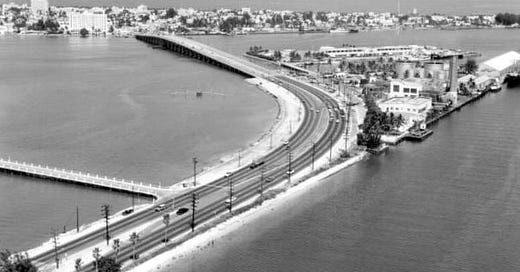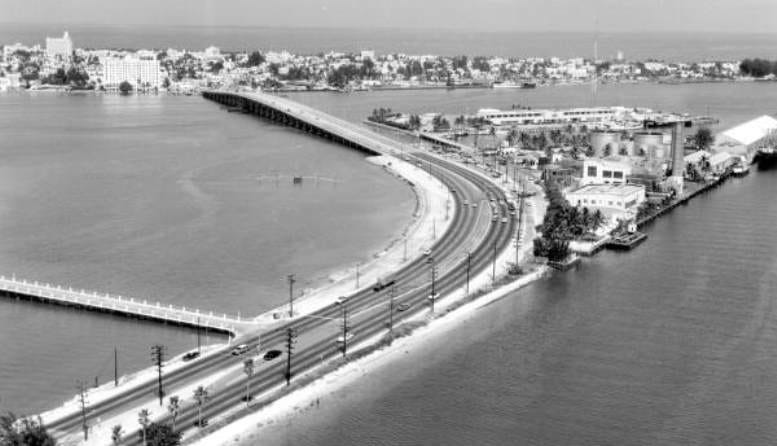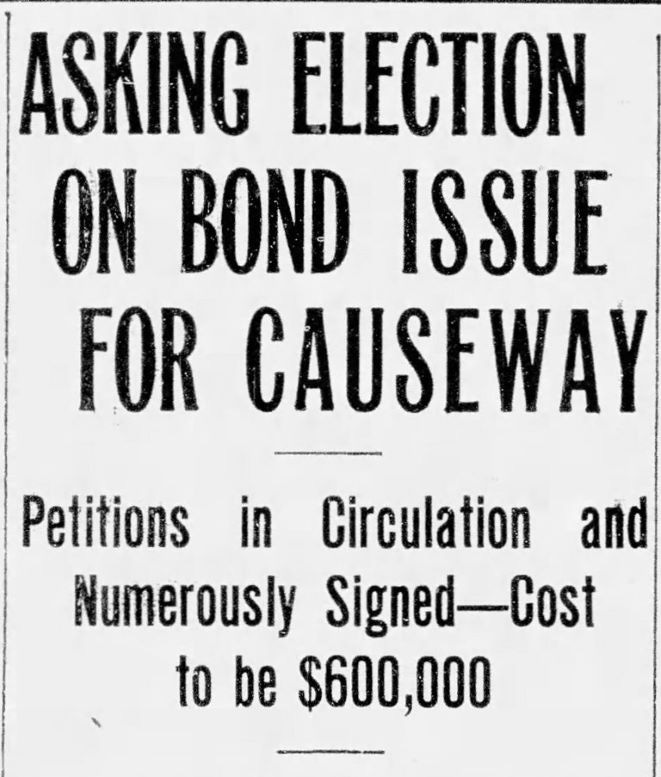History of the MacArthur Causeway
The story of the County Causeway which began construction in 1915, but did not get completed until after World War I. It opened on February 17, 1920, and was renamed to the MacArthur Causeway in 1942.
By the mid-1910s, some of the leaders of Miami and Miami Beach knew that the time would come when the region would outgrow the Collins Bridge, which was the only viaduct to join the two cities over Biscayne Bay. It was a privately-owned thoroughfare that charged each automobile a toll of 20 cents each direction to use the bridge. In order to accommodate the growth on both sides of the bay, these same leaders appealed to Dade County officials of the need for a second bridge.
It would take cooperation from several municipalities and a lot of patience to build the first publicly funded causeway. The county causeway, as it was originally referred, had its share of adversity, but it did finally open at the onset of a decade that would see both Miami and Miami Beach grow at an unprecedented rate. The bridge has changed names and has been updated several times during its 100-year history, but it still serves as a vital thoroughfare for a growing South Florida population.
Agreement to Build the Causeway
When the Dade County Commission decided to fund and construct a new causeway over Biscayne Bay in 1915, they first needed to get the approval and a permit from the United States War Department. According to an article in the Miami Metropolis on August 30, 1915: “approval of the causeway plans must be had from the war department before any work can be done. A free channel through the causeway must be left, also sufficient openings all along so that water can flow back and forth between the upper and lower bay.” This approval may have been related to the covenants of the dredging and creation of Government Cut in 1905 which provided a shipping lane from the Atlantic Ocean to the municipal docks, which was located in today’s Museum Park. The federal government paid for the “cut” and therefore may have had a say in other projects effecting the shipping lane. The approval was granted on December 27, 1915.
The county also needed cooperation from the cities of Miami and Miami Beach to deed land for the entrance of the causeway on each respective side of the bay. Locke T. Highleyman, a Miami City Councilman at the time, was the lone dissenter in approving the plan for the causeway on behalf of the city of Miami. He felt that taxpayers shouldn’t be asked to fund such an elaborate project.
At the time, Highleyman was developing the Point View subdivision in Brickell and it was customary for the developer to pave and name the streets, as well as, provide the infrastructure for their project. Despite his initial concerns, he later aligned with the other city councilman and dropped his objection once an agreement was reached between the county and the city in October of 1916. Ironically, he would benefit from the causeway in the 1920s when he and his partner, Clarence Busch, created and developed Hibiscus and Palm Islands.
While the city and county negotiated an agreement, the county began a petition drive to gauge interest in a bond issue to raise enough money to construct the causeway. The drive indicated a strong interest in pursuing a bond issue and on July 18, 1916, County Chairman, S.A. Belcher presented the findings to the board of county commissioners. As reported in the Miami Metropolis in an article on July 9, 1916, Belcher requested that “a bond election be called at the earliest possible moment for the purpose of voting bonds in the sum of $600,000 for the purpose of erecting and constructing a causeway or highway consisting partly of rock fill and partly of bridge work between the city of Miami and the town of Miami Beach, according to plans approved by the war department of the United States government.”
Realizing that a second bridge to Miami Beach would benefit their business interests greatly, Carl Fisher and the Lummus brothers donated $2,000 to finance the costs associated with the special election. Just a few weeks after the board of commissioners gave their blessing, Dade county voters unanimously approved the bond issue by a two to one margin on August 23, 1916. The tax to repay the bond was figured to add $2.50 for every $3,000 in property value within Dade county.
Two months later, on October 16, 1916, the county and city of Miami came to an agreement to construct the causeway on public property. The county granted the city of Miami the right to build a steam railroad over the causeway at a later date. However, the county was granted the right to build a streetcar line over the causeway until the railroad tracks were constructed. While the county managed streetcar line operated from 1927 until 1939, the railroad was never built by the city.
Keep reading with a 7-day free trial
Subscribe to Miami History to keep reading this post and get 7 days of free access to the full post archives.





